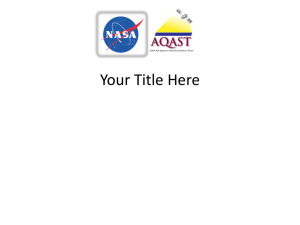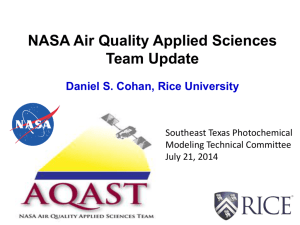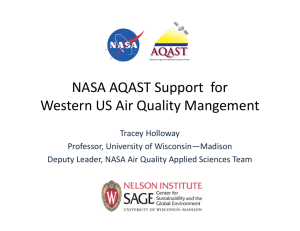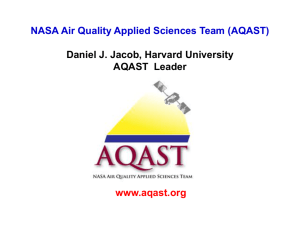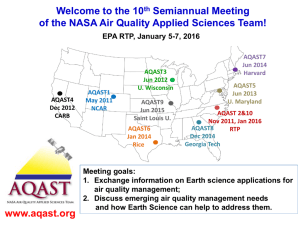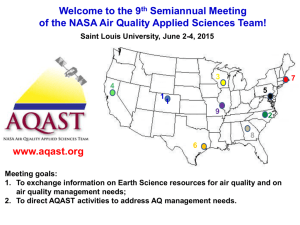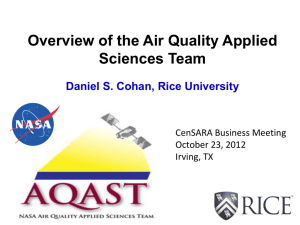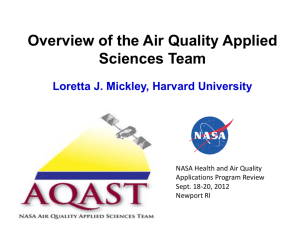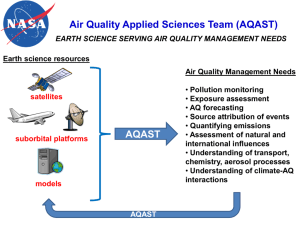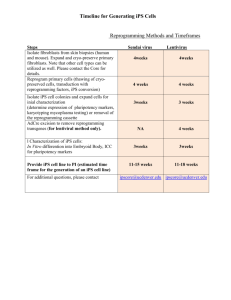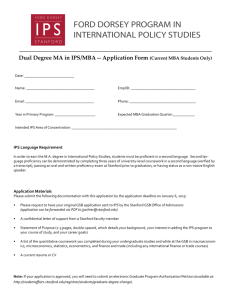PPT
advertisement
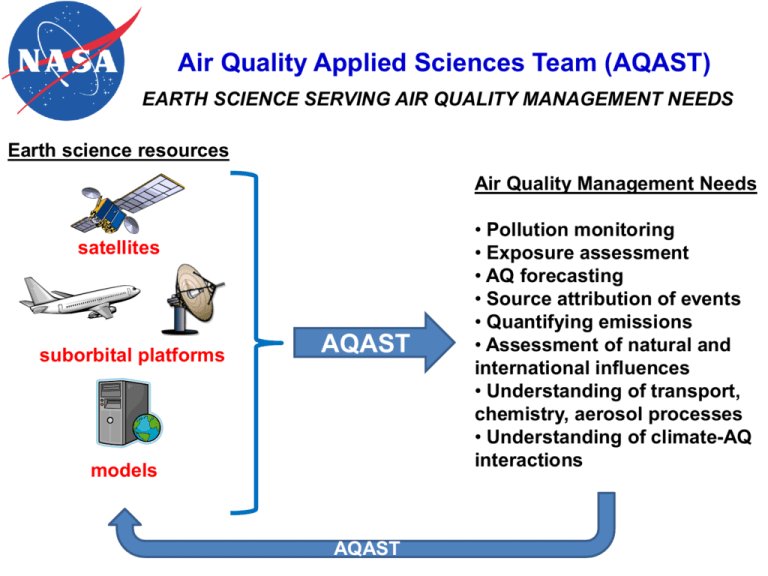
Air Quality Applied Sciences Team (AQAST) EARTH SCIENCE SERVING AIR QUALITY MANAGEMENT NEEDS Earth science resources Air Quality Management Needs satellites suborbital platforms AQAST models AQAST • Pollution monitoring • Exposure assessment • AQ forecasting • Source attribution of events • Quantifying emissions • Assessment of natural and international influences • Understanding of transport, chemistry, aerosol processes • Understanding of climate-AQ interactions AQAST Membership: PIs and Co-Is • Daniel Jacob (leader), Loretta Mickley (Harvard) • Greg Carmichael (U. Iowa) • Dan Cohan (Rice U.) • Russ Dickerson (U. Maryland) • Bryan Duncan, Yasuko Yoshida, Melanie Follette-Cook (NASA/GSFC); Jennifer Olson (NASA/LaRC) • David Edwards (NCAR) • Arlene Fiore (NOAA/GFDL); Meiyun Lin (Princeton) • Jack Fishman, Ben de Foy (Saint Louis U.) • Daven Henze, Jana Milford (U. Colorado) • Tracey Holloway, Steve Ackerman (U. Wisconsin); Bart Sponseller (Wisconsin DRC) • Edward Hyer, Jeff Reid, Doug Westphal, Kim Richardson (NRL) • Pius Lee, Tianfeng Chai (NOAA/NESDIS) • Yang Liu, Matthew Strickland (Emory U.), Bin Yu (UC Berkeley) • Richard McNider, Arastoo Biazar (U. Alabama – Huntsville) • Brad Pierce (NOAA/NESDIS) • Ted Russell, Yongtao Hu, Talat Odman (Georgia Tech); Lorraine Remer (NASA/GSFC) • David Streets (Argonne) • Jim Szykman (EPA/ORD/NERL) • Anne Thompson, William Ryan, Suellen Haupt (Penn State U.) AQAST organization • AQAST supports two types of projects: Investigator Projects (IPs). These involve typically a single AQAST member working with an air quality management partner; Tiger Team Projects (TTPs). These involve a collaboration of several AQAST members pooling their expertise to address urgent needs from one or more air quality management partners. • AQAST projects must bridge Earth Science and air quality management: Focus on use of Earth Science resources Clear air quality management outcomes 1-year deliverables of value for air quality agencies • AQAST has great flexibility in how it allocates its resources Members are encouraged to adjust their IPs to the evolving needs of air quality management The TTPs are redefined yearly to address the most pressing needs The team is self-organizing and can respond quickly to demands Scope of current AQAST projects (IPs and TTPs) Partner agency • Local: RAQC, BAAQD • State: TCEQ, MDE, Wisconsin DNR, CARB, Iowa DNR, GAEPD, GFC • Interstate: EPA Region 8, LADCO • National: NPS, NOAA, EPA Theme Satellites: MODIS, MISR, MOPITT, AIRS, OMI, TES, GOES Suborbital: ARCTAS, DISCOVER-AQ, ozonesondes, PANDORA Models: MOZART, CAM AM-3, GEOS-Chem, RAQMS, STEM, GISS, IPCC Earth Science resource AQAST SCHEDULE - Oct 2012: TTP new TTPs initiated - Aug 2012: team telecon - new TTP proposals reviewed - May 2012: next AQAST meeting - report on IPs, kick-off for new IPs - progress report for TTPs - Nov 2011: RTP meeting - progress reports for IPs - kick-off for TTPs - Oct 2011: 1st round of TTPs initiated - Aug 2011: team telecon -TTP proposals reviewed - May 2011: Boulder meeting - kick-off for 1st round of IPs - Jan 2011: team selected web site Ning site AQAST bimonthly newsletter - subscribe through web site
